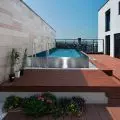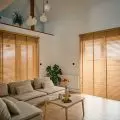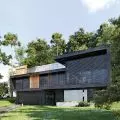The interview with Christian Pagh appeared
in A&B 6'2021
"Mission Neighborhood - (Re)forming Community" is the working title of the Oslo Architecture Triennale's fall 2022 edition. Its curator, Christian Pagh, is already talking about how the Triennale can interact with the community, what can be changed and shared, and what issues in urban design need to be rethought.
The event is sponsored by Architecture&Business [OAT 2022].
Dominika Drozdowska: Why is the Neighborhoods mission so important right now?
Christian Pagh: I think that cities and their contemporary planning are currently missing a very important element - the social aspects of everyday life. This is happening in Norway and in our Nordic backyard, but also all over the world. When we look at cities historically, we see that they were designed in such a way that work and all manufacturing, service or commercial activities were embedded in daily life. And daily life was embedded in the urban fabric and inherent in collectivity and community. The obvious choice was to move around the city on foot. When we rewind the tape of history forward and get to design in the spirit of modernism or contemporary, we can conclude that there is a lack of space for community. The residential buildings being built in Norway today are very egocentric. They lack vision and concern for the community. That's why I think the participants who create the common good should rethink these issues.



Løren, a new neighborhood in Oslo - an example of an unfavorable neighborhood solution
© Oslo Architecture Triennale
Dominik: Looking at the residential spaces that are being built nowadays in Poland - estates without playgrounds, in suburbs without access to transportation - the assumptions built decades ago in the spirit of modernism seem brilliantly planned. Do you think any particular type of space needs intervention the most?
Christian: That's true, although there was a lot of bad planning a few decades ago, for example in the 1970s, too. That's why I think today we need to imagine what the community of the future might look like. What will be its meaning? What kind of residential neighborhoods might there be? The modernists, for example, had one vision of reality, and ideas about the future can be more diverse in different aspects, also depending on the place or context. Nowadays we are inspired by different things than the modernists, so the aesthetics and scale of designed space should change. Let's opt for diversity.
Dominika: Tell us, please, what activities are you planning for the Oslo Architecture Triennale?
Christian: We have formulated the Triennale as an open laboratory that will be accessible to a wide audience: architects and urban planners, politicians, academia, representatives of the development industry. This fall, we plan to open calls for projects, those completed, but also visionary ideas and concepts showing a variety of approaches to the subject of neighborhoods. We are also planning activities within the network of Nordic cities - larger ones like Copenhagen and Helsinki, and smaller ones like Aarhus and Bergen. As part of local activities, in the Oslo space we would like to invite project offices and local participants to work together to create visions for the future neighborhood. All of these activities will lead up to the Triennale, which will take place in the fall of 2022 and will be packed with festival events such as city walks, talks and debates, installations in public spaces and exhibitions.



Grønland, Oslo - an example of a diverse and vibrant neighborhood
© Oslo Architecture Triennale
Dominika: So the Oslo Architecture Triennale can be attended by a designer or activist from Poland?
Christian: Yes, we invite you as part of the autumn call for projects and visions, realized and conceptual. This can be an interesting opportunity for designers to share their work and thoughts with a wider audience. For us, it will certainly be an informative overview of what is happening internationally on neighborhood issues. Especially since these visions can represent completely different scales: from urban, to urban, to small local actions.
Dominika: So you are open to all ideas.
Christian: As long as they are good projects - sensitive to the community, the urban fabric, offering places of contact and meeting. But it's a fact, we are quite open to different ideas!
Dominika: Do you also intend to leave any traces after the Triennale ends in the Oslo space?
Christian: Yes, this is one of the key elements and ambitions of this festival. We would like people to think and act differently after the Oslo Architecture Triennale than before. We plan to work on neighborhood issues in a broader sense - political, economic, sociological. What should be the role of the political system, public and state institutions in planning processes? Let's not kid ourselves, after all, the topic of neighborhoods requires infrastructural and financial inputs. Creating a set of best practices, tips and tools, we will share the knowledge and recommendations developed with our partners.
Dominika: That's great that you're talking about sharing knowledge.
Christian: Yes, we will share the results developed. As I said, already at this stage we intend to collaborate and share experiences with other Nordic cities, including on the planning system, regulations, raising the bar for developers, participation of architects, local communities and politicians in design processes. The focus is on local Nordic specifics, which have similar conditions, context and needs.
{Image@url=https://cdn.architekturaibiznes.pl/upload/galerie/51584/images/original/989ed85c0a9ca19948daed2d7a1a2bff.jpg,alt=Grünerløkka - example of a widely used semi-public courtyard from the 1960s,title=Grünerløkka - example of a widely used semi-public courtyard from the 1960s}
Grünerløkka - an example of a widely used semi-public courtyard from the 1960s}
© Oslo Architecture Triennale
Dominik: The question is, how do you implement these tools and effects you're talking about into real action? How do you engage the local community so that the practices developed work in the long term?
Christian: The neighborhood space can be characterized by three types. The first is the crazy pat-developer, that is, a developer who builds according to a "political" decision, without much sense, just for profit. A neighborhood built this way is defined by money and power. The second example is an approach in which we think about the users, based on a sound design, prepared by a group of specialists in various fields. The last type is spaces that already exist. The Oslo Architecture Triennale targets the second type of space. We want to show that by designing wisely, it is possible to rethink a space so as to develop more space for the neighborhood. So back to the question about the local community - although I would love to, I'm not sure we will be able to mobilize the whole community of Norway.
Dominica: I'm also wondering what could be done to encourage residents to take action around the shared space. The Polish peculiarity is the attachment to property - so the common space, although it has a huge impact on everyday life, is considered to be nobody's, its quality is very poor. Who should create this space, take care of it and maintain it?
Christian: It's very difficult to get people to take care of the common space. We don't always do what's good for us - after all, we know we shouldn't fly, and we fly. We know we shouldn't eat fish, and we overfish bodies of water anyway. It's the same with space. Therefore, I think the first step should be a conversation. The next - involvement on the part of public institutions. After all, schools, kindergartens, libraries, museums - they could share their space with local residents. We could then demand the same - sharing space - from private companies. The entire community could benefit from such actions. But to make a difference, we need to start talking about it.
Dominika: With solutions like this, the space is open to everyone and used all the time.
Christian: Yes, someone is the formal owner, but the space is inclusive and works for everyone - a good combination in my opinion.



Parkteatret, a café and cultural venue in Grünerløkka - an example of an important meeting place in the neighborhood
© Oslo Architecture Triennale
Dominik: It seems like it's a matter of changing our thinking and approach - thinking about what else we could share and make available to each other.
Christian: Yes, it can be compared in a rather trivial and simple way to the currently overused topic of ecology. Let's take a forest, where all the elements of flora and fauna interact with each other, derive nutritional value from each other, so that the whole thing functions in one common cycle. The same synergy should function in the city. The problem with modern planning, however, is that we do everything ourselves, drive to work by car, pick up a child from school by car, shop and return to where we live. What is missing in this is interaction and community.
Dominika: In creating the outlines of the Oslo Architecture Triennale, you were inspired by ideas for a collectively organized city like Barcelona's Superblocks or Paris' fifteen-minute city. Do you plan to generate another super idea during the Triennale?
Christian: I hope that we will do a great job together, that we will do something really fantastic! But on the other hand, we're not doing anything avant-garde - many cities have their own ideas and are working to create better spaces. We will definitely take inspiration from what has already been created. We are not aiming to produce a unique idea - we would like to arrive at what is right and proper, to make people change their way of thinking and rethink some important issues.
Dominika: You talk about systemic change. Does this only apply to sharing issues?
Christian: Not only. Let's consider: why is the planning system so inefficient that developers can build spaces of really bad quality? The system should be able to provide us with good quality space. In preparing the Triennial, I talked to a great many people, mainly from Norway, but also from other Nordic countries: architects, urban planners, officials, politicians, developers, local activists. It is worth considering how decision-makers could enable us to live well in the neighborhood. We need to look together for systemic solutions to create fantastic shared spaces - diverse, open and good to live in.
Dominika: In what way? By changing regulations, by focusing on education?
Christian: I think you have to bring the different elements together. Laws, regulations, design processes, planning culture. So that the creation of architecture and space is not based on negotiations between lawyers, but is a real creative process, emerging good visions and scenarios for the future.



Grünerløkka - example of an old playground still in use
© Oslo Architecture Triennale
Dominik: So the purpose of the Triennale is mainly to think about these issues.
Christian: We have three issues. The first is the neighborhood as the space between buildings that we share with each other. The second is space planning with public institutions such as schools. And finally, systemic issues related to processes and management.
Dominica: Sounds ambitious! Tell us, please, finally, what do you think a good neighborhood space is?
Christian: I don't want to sound old-fashioned, but I think many former European cities represent a good neighborhood space with a variety of offerings and opportunities. This is the case in Copenhagen, among others. I think that by being part of a good neighborhood, you can just live a better and healthier life - both physically and mentally.
Dominica: Thank you for the interview.
interviewed: Dominika Drozdowska
Illustrations provided courtesy of the organizers of the Oslo Architecture Triennale.





























